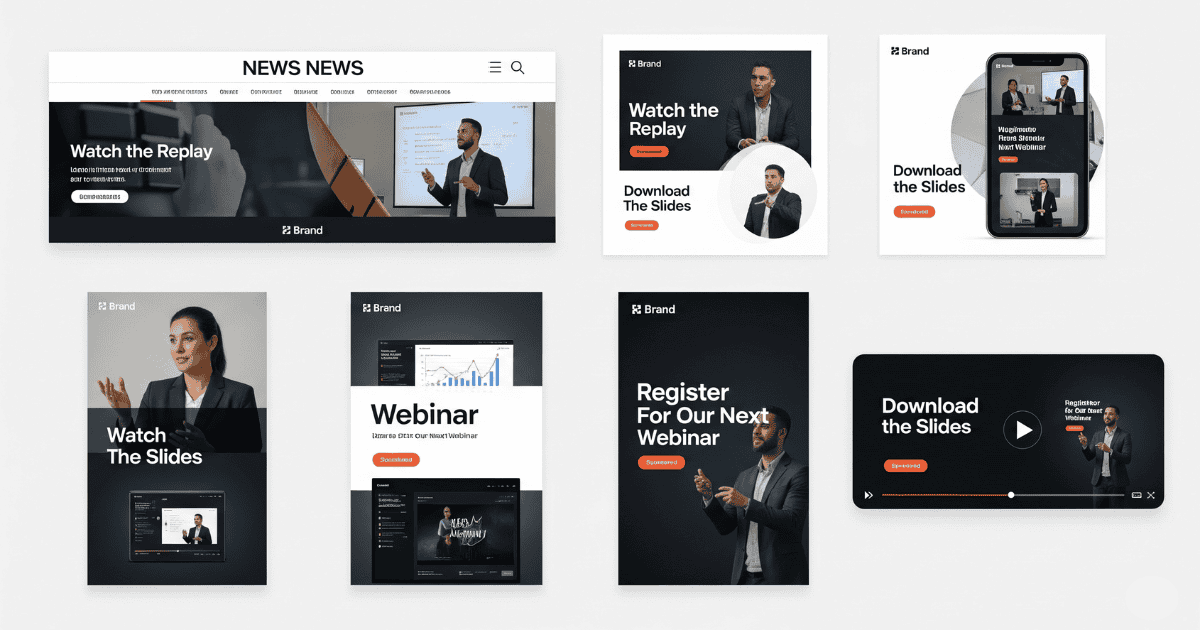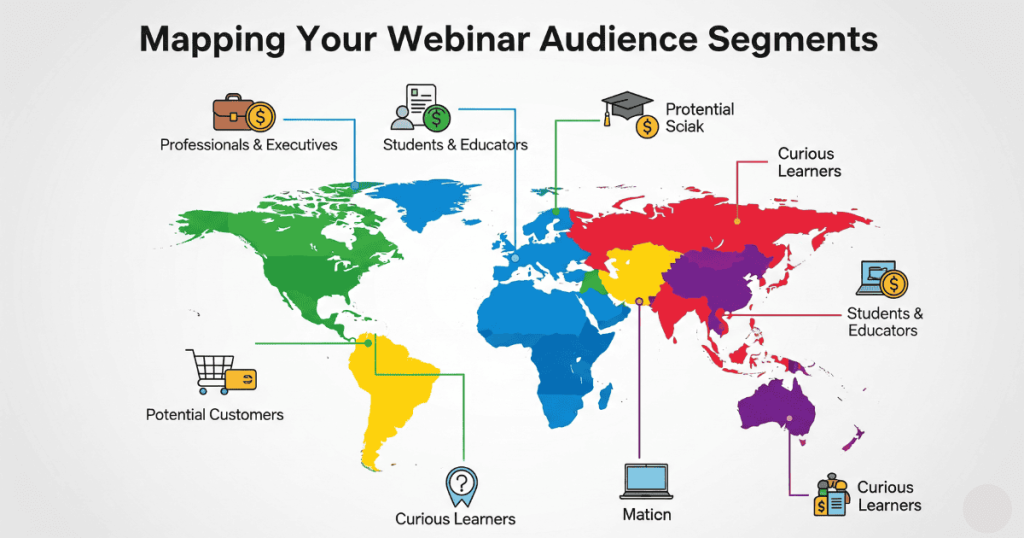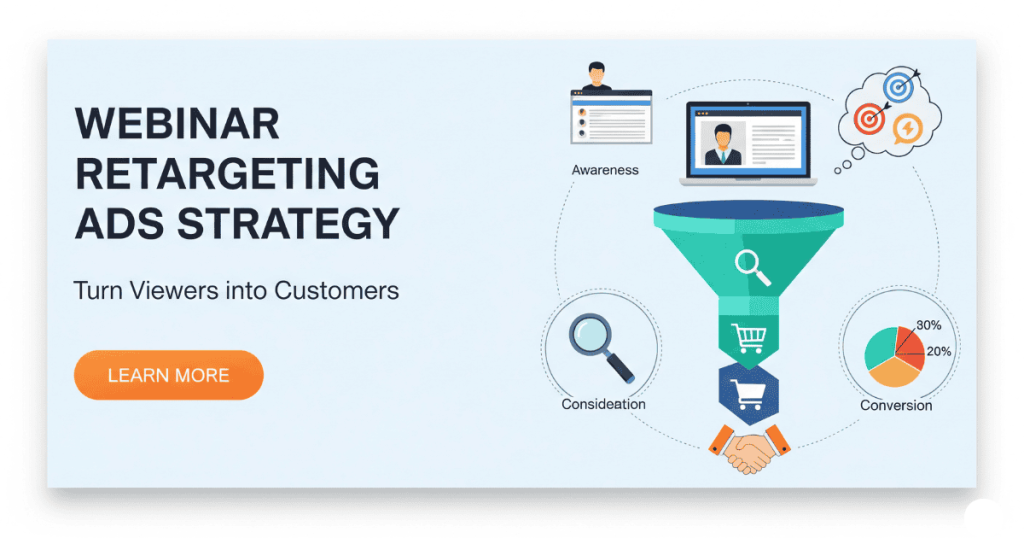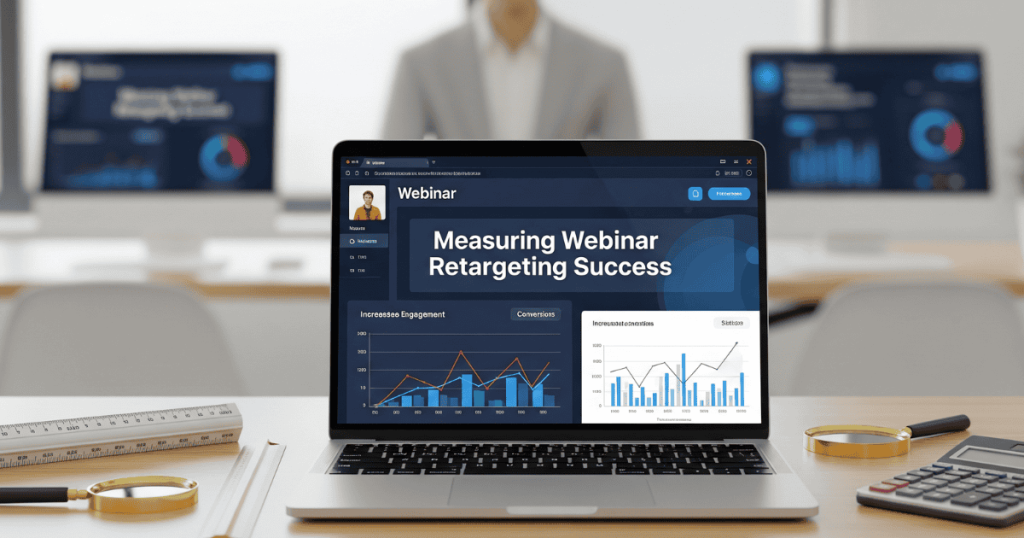
You’ve spent weeks planning your webinar. You’ve created compelling content, designed eye-catching promotional materials, and successfully attracted hundreds of registrations. The event goes smoothly, but then reality hits: only a fraction of your audience converts into paying customers.
Sound familiar? You’re not alone. Most webinars see conversion rates between 2-5%, meaning 95-98% of your carefully cultivated audience walks away without taking action. That’s where webinar retargeting ads come into play.
Retargeting ads allow you to reconnect with people who’ve already shown interest in your content by visiting your webinar registration page, attending your session, or engaging with your brand. Instead of letting these warm leads slip away, you can strategically guide them through your sales funnel with targeted messaging that addresses their specific stage in the buyer’s journey.
This comprehensive guide will walk you through proven retargeting strategies for webinars, from setting up your first campaign to optimizing for maximum ROI. You’ll discover how to segment your audiences effectively, craft compelling ad creative, and turn your webinar traffic into a sustainable revenue stream.
Understanding Webinar Retargeting Fundamentals
Webinar retargeting ads work by placing tracking pixels on key pages of your webinar funnel. These pixels collect data about visitor behavior, allowing you to create custom audiences based on specific actions people have taken.
The beauty of webinar remarketing techniques lies in their precision. Unlike cold advertising, you’re reaching people who’ve already demonstrated interest in your topic, making them significantly more likely to convert. Research shows that retargeted visitors are 70% more likely to convert compared to first-time website visitors.
Your retargeting strategy should align with the natural progression of your webinar funnel. Someone who registered but didn’t attend needs different messaging than someone who attended but didn’t purchase. This behavioral data becomes the foundation for creating highly targeted campaigns that speak directly to each audience segment’s needs and hesitations.
The key is understanding that webinar attendees exist at different stages of awareness. Some are just discovering their problem, while others are actively comparing solutions. Your retargeting campaigns should reflect these varying levels of intent and guide each segment toward the most appropriate next step.
Mapping Your Webinar Audience Segments

Effective retargeting starts with proper audience segmentation. Not all webinar visitors are created equal, and treating them as such will dilute your messaging and waste your advertising budget.
Registration Page Visitors Who Didn’t Register
These visitors showed initial interest but didn’t commit. They might have been researching your topic, comparing webinars, or simply got distracted. For this segment, focus on addressing common objections and highlighting the unique value your webinar provides. Emphasize social proof, such as the number of people already registered or testimonials from previous attendees.
Registered Attendees Who Didn’t Show Up
Life happens, and even interested prospects sometimes miss webinars. This audience segment already found your content valuable enough to register, making them prime candidates for retargeting. Offer them access to the webinar recording, highlight key takeaways they missed, or promote your next live session.
Webinar Attendees Who Didn’t Convert
These people invested their time in your presentation but didn’t take the final step. They’re warm leads who understand your value proposition but may need additional nurturing. Address common concerns, offer limited-time incentives, or provide additional resources that build trust and demonstrate expertise.
Partial Attendees Who Left Early
Early departures might indicate content that didn’t match expectations or personal scheduling conflicts. For these prospects, focus on the most compelling parts of your presentation that they missed, or offer alternative content formats that might better suit their needs.
Engaged Attendees Who Asked Questions
People who actively participated in your webinar represent your hottest leads. They’re engaged, interested, and likely close to making a decision. Prioritize this segment with your most compelling offers and direct response campaigns.
Facebook Retargeting for Webinars: Setup and Strategy
Facebook’s robust targeting capabilities make it an excellent platform for webinar remarketing. The platform’s detailed audience insights allow you to refine your targeting based on demographics, interests, and behaviors beyond just webinar attendance.
Start by installing the Facebook Pixel on all key pages of your webinar funnel. This includes your registration page, thank-you page, webinar hosting platform, and any sales pages. The pixel will track visitor behavior and enable you to create custom audiences for retargeting.
Create separate custom audiences for each stage of your funnel. Facebook allows you to set audience duration from 1 to 180 days, giving you flexibility in how long you want to retarget each segment. For webinar audiences, a 30-60 day window typically provides the best balance between relevance and reach.
Use Facebook’s lookalike audience feature to expand beyond your existing webinar attendees. Create lookalike audiences based on your highest-value segments, such as attendees who purchased or people who watched more than 75% of your presentation. This helps you find new prospects with similar characteristics to your best customers.
Video ads tend to perform exceptionally well for webinar retargeting on Facebook. Create short clips highlighting key insights from your presentation, testimonials from previous attendees, or behind-the-scenes content that builds personal connection. The platform’s auto-playing video format captures attention quickly and can effectively communicate your value proposition.
Google Ads Retargeting for Online Events
Google Ads retargeting operates differently from social media platforms but offers unique advantages for webinar promotion. The intent-based nature of search advertising means you can capture people actively looking for solutions related to your webinar topic.
Set up Google Analytics Enhanced Ecommerce tracking to capture detailed information about your webinar funnel performance. This data will help you identify which traffic sources produce the highest-quality attendees and optimize your retargeting accordingly.
Display retargeting through Google Ads allows you to reach your webinar visitors across millions of websites in the Google Display Network. Create visually appealing banner ads that remind prospects about your webinar offer and guide them back to your registration or sales page.
YouTube retargeting presents an excellent opportunity for webinar promotion. Since YouTube is owned by Google, you can retarget your webinar visitors with video ads on the platform. Create compelling video testimonials, preview content, or case studies that reinforce your expertise and encourage conversion.
Search retargeting lets you show ads to people who’ve visited your webinar pages when they search for related terms on Google. This combines the power of intent-based search with the warm audience of your webinar visitors, often resulting in higher conversion rates and lower costs per acquisition.
Crafting High-Converting Webinar Retargeting Creative
Your ad creative makes or breaks your retargeting campaign success. Generic promotional messages won’t resonate with audiences who’ve already experienced your content. Instead, your creative should acknowledge their previous interaction and provide compelling reasons to take the next step.
Address specific objections based on audience segment behavior. For people who registered but didn’t attend, focus on the value they missed and make it easy to catch up. For attendees who didn’t purchase, address common concerns about price, implementation, or results.
Use urgency and scarcity strategically but authentically. Limited-time bonuses, early-bird pricing, or restricted availability can motivate action, but only if they’re genuine. Your webinar audience has already experienced your content quality, so they’ll quickly spot inauthentic marketing tactics.
Social proof becomes even more powerful in retargeting creative. Highlight success stories from webinar attendees, showcase the number of people who’ve taken action since your presentation, or feature testimonials that address specific concerns your audience might have.
Increasing Webinar Sign-ups with Retargeting
While much of this guide focuses on converting existing webinar audiences, retargeting can also effectively boost registration numbers. This strategy works particularly well for evergreen webinars or recurring training sessions.
Target people who visited your webinar landing page but didn’t register with ads that address common hesitations. Price sensitivity, time commitment, and relevance concerns are typical barriers to registration. Your retargeting ads should directly address these objections with clear, benefit-focused messaging.
Create registration-focused campaigns that highlight unique aspects of your upcoming webinar. If you’re featuring guest experts, exclusive content, or limited-time offers, make these elements prominent in your retargeting creative.
Use sequential messaging to build interest over time. Show different ads to the same audience over several days, gradually building the case for attendance. Start with awareness-focused content, move to benefit-heavy messaging, and finish with urgency-driven calls to action.
Best Retargeting Platforms for Webinars
While Facebook and Google dominate the retargeting landscape, other platforms offer unique advantages for webinar promotion. LinkedIn excels for B2B webinars, particularly those targeting specific professional roles or industries. The platform’s professional context makes it ideal for educational content and thought leadership positioning.
Twitter retargeting works well for webinars with trending or timely topics. The platform’s real-time nature and hashtag culture can amplify your reach, especially if your webinar addresses current industry challenges or news.
Email retargeting through platforms like Mailchimp or ConvertKit allows for more detailed, personalized messaging. You can segment your email lists based on webinar behavior and deliver targeted content sequences that nurture leads toward conversion.
Consider multi-platform retargeting sequences that reinforce your message across different touchpoints. A prospect might see your Facebook ad, then encounter your Google display ad, and finally receive a targeted email. This omnichannel approach increases brand recall and conversion likelihood.
Retargeting Campaign Optimization Strategies

Successful retargeting requires continuous optimization based on performance data. Start by establishing clear metrics for each campaign objective, whether that’s webinar registrations, sales conversions, or lead generation.
Monitor frequency caps closely to avoid ad fatigue. Most platforms allow you to limit how often individual users see your ads. For webinar retargeting, showing ads 3-5 times per week typically provides good results without overwhelming your audience.
A/B test different creative formats, messaging approaches, and calls to action. What works for one audience segment might not work for another. Test video vs. image ads, long-form vs. short copy, and different value propositions to identify top performers.
Adjust your bidding strategy based on audience segment value. People who attended your full webinar are worth more than those who just visited your registration page. Use platform features like value-based bidding to automatically optimize for your highest-value conversions.
Converting Webinar Leads with Retargeting
The ultimate goal of webinar retargeting is conversion, whether that means product purchases, consultation bookings, or program enrollments. Your conversion-focused campaigns should remove as much friction as possible from the buying process.
Create dedicated landing pages for your retargeting traffic that acknowledge their previous webinar attendance. Reference specific content from your presentation, address questions that came up during the session, and provide clear next steps for moving forward.
Offer multiple conversion paths to accommodate different buying preferences. Some prospects prefer to purchase immediately online, while others want to speak with someone first. Provide options for both instant purchases and consultation bookings.
Use dynamic product ads if you offer multiple services or products. These ads automatically show the most relevant offering based on previous behavior, increasing the likelihood of conversion by matching products to demonstrated interests.
Measuring Webinar Retargeting Success

Track both leading and lagging indicators to get a complete picture of your retargeting performance. Leading indicators like click-through rates and engagement metrics help you optimize campaigns in real-time, while lagging indicators like conversion rates and customer lifetime value measure ultimate success.
Set up proper attribution tracking to understand how retargeting fits into your overall marketing funnel. Many prospects will interact with multiple touchpoints before converting, so understanding the role of retargeting in the customer journey helps you allocate budget effectively.
Calculate return on ad spend (ROAS) for each audience segment and campaign type. This metric helps you identify your most profitable retargeting strategies and guides future budget allocation decisions.
Monitor customer lifetime value for retargeting-acquired customers compared to other acquisition channels. Retargeted webinar attendees often have higher lifetime value because they’ve already experienced your content quality and teaching style.
Maximizing Your Webinar Investment
Webinar retargeting ads transform your educational content into a sustainable lead generation and sales system. By strategically following up with people who’ve already shown interest in your expertise, you can dramatically improve your webinar ROI and build a more predictable revenue stream.
The key lies in understanding that different audience segments need different messages at different times. Your registration page visitors require different treatment than your engaged attendees, and your creative should reflect these varying needs and intentions.
Start with one platform and audience segment, then expand based on what works. Perfect your messaging and tracking for engaged webinar attendees before moving on to less qualified segments. This approach helps you learn what resonates with your audience while maximizing your initial results.
Remember that retargeting is about building relationships, not just driving transactions. Your ads should provide value, address concerns, and guide prospects toward solutions that genuinely help them achieve their goals. When done correctly, webinar retargeting creates win-win scenarios where prospects get the help they need while you build a thriving business.



















No Comments